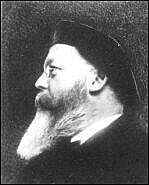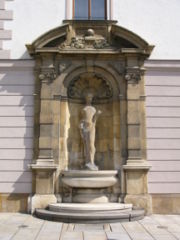
Camillo Sitte
Encyclopedia

Austria
Austria , officially the Republic of Austria , is a landlocked country of roughly 8.4 million people in Central Europe. It is bordered by the Czech Republic and Germany to the north, Slovakia and Hungary to the east, Slovenia and Italy to the south, and Switzerland and Liechtenstein to the...
n architect
Architect
An architect is a person trained in the planning, design and oversight of the construction of buildings. To practice architecture means to offer or render services in connection with the design and construction of a building, or group of buildings and the space within the site surrounding the...
, painter and city planning theoretician with great influence and authority of the development of urban construction planning and regulation in Europe.
Life
Camillo Sitte was an art historian and architect. He traveled around the towns of Europe and tried to identify aspects that made towns feel warm and welcoming. Architecture was a process of culturization for him. Sitte received a lot of attention in 1889 with the publication of his book "Der Städtebau nach seinen künstlerischen Grundsätzen" (English title: "City Planning According to Artistic Principles"). The richly illustrated book pointed out that the urban room around the experiencing man should be the leading motif of urban planning, thus turning away from the pragmatic, hygienic planning procedures of the time. Sitte emphasized the creation of an irregular urban structure, spacious plazas, enhanced by monuments and other aesthetic elements.Sitte founded the Camillo Sitte Lehranstalt and the Camillo Sitte Gasse in Vienna, and also the magazine Städtebau in 1904. Camillo Sitte was the son of the architect Franz Sitte (1808–79) and the father of the architect Siegfried Sitte (1876–1945).
Sitte is also credited with having invented the cul-de-sac
Cul-de-sac
A cul-de-sac is a word of French origin referring to a dead end, close, no through road or court meaning dead-end street with only one inlet/outlet...
.
City Planning According to Artistic Principles (1889)

Urban planning
Urban planning incorporates areas such as economics, design, ecology, sociology, geography, law, political science, and statistics to guide and ensure the orderly development of settlements and communities....
theory book, it has a deep influence in architecture, as the two disciplines are deeply intertwined. It was also highly successful in its time. Between 1889 and 1922 it was edited five times. It was translated into French in 1902, but was not translated into English until 1945.
For Sitte, the most important is not the architectural shape or form of each building, but the inherent creative quality of urban space, the whole as much more than the sum of its parts. Sitte contended that many urban planners had neglected to consider the vertical dimension of planning, instead focusing too much on paper, and that this approach hindered the efficacy of planning in an aesthetically conscious manner. Athens
Athens
Athens , is the capital and largest city of Greece. Athens dominates the Attica region and is one of the world's oldest cities, as its recorded history spans around 3,400 years. Classical Athens was a powerful city-state...
and the ancient Greek
Ancient Greece
Ancient Greece is a civilization belonging to a period of Greek history that lasted from the Archaic period of the 8th to 6th centuries BC to the end of antiquity. Immediately following this period was the beginning of the Early Middle Ages and the Byzantine era. Included in Ancient Greece is the...
spaces, like the agora
Agora
The Agora was an open "place of assembly" in ancient Greek city-states. Early in Greek history , free-born male land-owners who were citizens would gather in the Agora for military duty or to hear statements of the ruling king or council. Later, the Agora also served as a marketplace where...
and the forum
Forum (Roman)
A forum was a public square in a Roman municipium, or any civitas, reserved primarily for the vending of goods; i.e., a marketplace, along with the buildings used for shops and the stoas used for open stalls...
are his preferred examples of good urban spaces. He makes a study of the spatial structures of the cities, squares, monuments, and confronts the living beauty and creativity of the most ancient ones with the sterility of the new cities. In general:
- Sitte makes an analysis based on sensitivity aestheticsAestheticsAesthetics is a branch of philosophy dealing with the nature of beauty, art, and taste, and with the creation and appreciation of beauty. It is more scientifically defined as the study of sensory or sensori-emotional values, sometimes called judgments of sentiment and taste...
and is not concerned with the historical circumstances that generated such forms. Urbanism is to be lived today and thus must be judged according to today's needs and aesthetics;
- Criticizes the regular and obsessive orderClassical orderA classical order is one of the ancient styles of classical architecture, each distinguished by its proportions and characteristic profiles and details, and most readily recognizable by the type of column employed. Three ancient orders of architecture—the Doric, Ionic, and Corinthian—originated in...
of the new squares, confronting it with the irregularity of the medieval city. "A square should be seen as a room: it should form an enclosed space";
- Criticizes the isolated placement of Churches and monuments, and confronts it with how monuments were formerly presented to the viewer;
- With examples from ItalyItalyItaly , officially the Italian Republic languages]] under the European Charter for Regional or Minority Languages. In each of these, Italy's official name is as follows:;;;;;;;;), is a unitary parliamentary republic in South-Central Europe. To the north it borders France, Switzerland, Austria and...
, AustriaAustriaAustria , officially the Republic of Austria , is a landlocked country of roughly 8.4 million people in Central Europe. It is bordered by the Czech Republic and Germany to the north, Slovakia and Hungary to the east, Slovenia and Italy to the south, and Switzerland and Liechtenstein to the...
and GermanyGermanyGermany , officially the Federal Republic of Germany , is a federal parliamentary republic in Europe. The country consists of 16 states while the capital and largest city is Berlin. Germany covers an area of 357,021 km2 and has a largely temperate seasonal climate...
, he defines a square typologyTypologyTypology is the study of types. More specifically, it may refer to:*Typology , division of culture by races*Typology , classification of things according to their characteristics...
, an "enclosed squares' system of the ancient times". He studies from a psychological viewpoint the perception of the proportions between the monuments and its surroundings, opposing the fashion of very wide streets and squares, and the dogma of orthogonality and symmetry;
- He fears that Urbanism would have become a mere technical task without any artistic involvement. He acknowledges an antagonism between the picturesque and the pragmatic, and states that these restrain the works of the artists. The building of another Acropole would become impossible, not only because of the financial means, but also the lack of the basic artistic generating thought;
- He stated that an urban planner should not be too concerned with the small design. The city should only take care of the general streets and structure, while the rest would be left to private initiative, just as in ancient cities;
- He Provides an example of his theories at the end of one of his books in the form of the redesign of ViennaViennaVienna is the capital and largest city of the Republic of Austria and one of the nine states of Austria. Vienna is Austria's primary city, with a population of about 1.723 million , and is by far the largest city in Austria, as well as its cultural, economic, and political centre...
's RingCircleA circle is a simple shape of Euclidean geometry consisting of those points in a plane that are a given distance from a given point, the centre. The distance between any of the points and the centre is called the radius....
, a circular avenue.
His theories were widely influential for many practiticians, like Karl Henrici and Theodor Fischer
Theodor Fischer
Theodor Fischer was a German architect and teacher.Fischer planned public housing projects for the city of Munich beginning in 1893. He was the joint founder and first chairman of the Deutscher Werkbund , as well as member of the German version of the Garden city movement...
. Modernist movements rejected these thoughts and Le Corbusier
Le Corbusier
Charles-Édouard Jeanneret, better known as Le Corbusier , was a Swiss-born French architect, designer, urbanist, writer and painter, famous for being one of the pioneers of what now is called modern architecture. He was born in Switzerland and became a French citizen in 1930...
is known for his energetic dismissals of the work. Nevertheless, his work is often used and cited as a criticism of the Modernist movement, its importance reemerging in the post-modernist movement of the late sixties.
Books by him
- City Planning According to Artistic Principles, 1889
- The Birth of Modern City Planning. Dover Publications, 2006, ISBN 978-0486451183
- Gesamtausgabe. Schriften und Projekte. Hrsg. v. Klaus Semsroth, Michael Mönninger und Christine Crasemann-Collins. 6 Bände. Böhlau, Wien 2003–2007
Literature
- Karin Wilhelm, Detlef Jessen-Klingenberg (Hrsg.): Formationen der Stadt. Camillo Sitte weitergelesen (= Bauwelt Fundamente; Bd. 132). Birkhäuser, Basel; Bauverlag, Gütersloh u. a. 2006, ISBN 3-7643-7152-8
- George R. Collins & Christiane Crasemann Collins. Camillo Sitte and the Birth of Modern City Planning. Random House: New York, 1965.
- Michael Mönninger: Vom Ornament zum Nationalkunstwerk. Zur Kunst- und Architekturtheorie Camillo Sittes. Vieweg, Wiesbaden 1998, ISBN 3-528-02423-2
- Leif Jerram: From Page to Policy: Camillo Sitte and Planning Practice in Munich. Manchester Papers in Economic and Social History, No. 57, September 2007. ISSN 1753-7762. An introduction to Sitte, alongside an analysis of how his ideas were actually used. Available online at http://www.arts.manchester.ac.uk/subjectareas/history/research/manchesterpapers/ .

